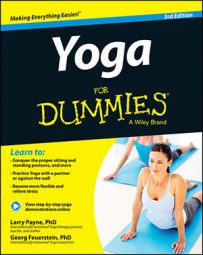The asymmetrical forward bend Yoga posture stretches each side of the back and hamstrings separately. The Sanskrit word parshva (pronounced pahr-shvah) means “side” or “flank,” and this posture indeed opens the hips, tones the abdomen, decompresses the neck, improves balance, and increases circulation to the upper torso and head.
Stand in the mountain posture and, as you exhale, step forward about 3 to 3 1/2 feet (or the length of one leg) with your right foot.
Your left foot turns out naturally, but if you need more stability, turn it out even more — but not past 45 degrees.
Place your hands on the top of your hips, and square the front of your pelvis; release your hands and hang your arms.
As you inhale, raise your arms forward and then overhead.
![[Credit: Photograph by Adam Latham]](https://www.dummies.com/wp-content/uploads/431566.image0.jpg) Credit: Photograph by Adam Latham
Credit: Photograph by Adam LathamAs you exhale, bend forward from the hips, soften your right knee and both arms, and hang down.
If your head isn’t close to your right knee, bend your knee more. If you have the flexibility, straighten your right knee — but keep it soft.
As you inhale, roll up slowly, stacking the bones of your spine one at a time from the bottom up, and then raise your arms overhead; relax your head and neck downward.
Rolling up is the safest way to come up, but if you don’t have back problems, you may want to try more advanced techniques after a few weeks.
Repeat Steps 3 and 4 three times, and then stay in Step 4 for 6 to 8 breaths.
Repeat the same sequence on the left side.
In the classic version of this posture, both legs are straight and the forehead presses against the forward leg.
To make the posture more challenging, square your hips forward and rotate your back foot inward.

